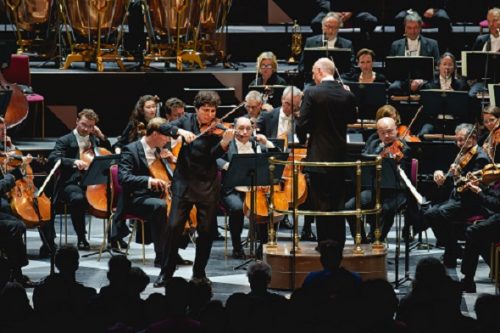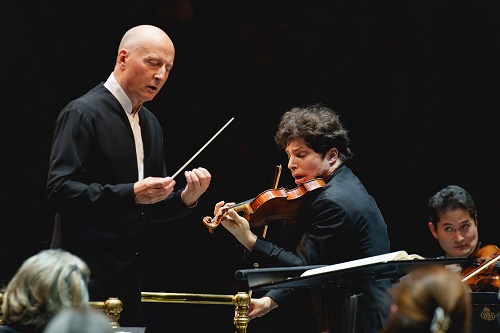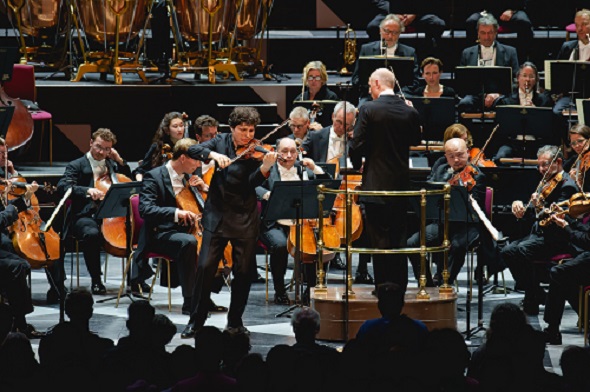
 United Kingdom Prom 59 – Beethoven, Tchaikovsky, Dvořák: Augustin Hadelich (violin), Tonhalle-Orchester Zürich / Paavo Järvi (conductor). Royal Albert Hall, London, 30.8.2023. (CS)
United Kingdom Prom 59 – Beethoven, Tchaikovsky, Dvořák: Augustin Hadelich (violin), Tonhalle-Orchester Zürich / Paavo Järvi (conductor). Royal Albert Hall, London, 30.8.2023. (CS)

Beethoven – Overture, ‘The Consecration of the House’
Tchaikovsky – Violin Concerto in D major, Op.35
Dvořák – Symphony No.9 in E minor, Op.95, ‘From the New World’
The last time the Tonhalle-Orchester Zürich visited the Proms it was the occasion of David Zinman’s farewell to the orchestra. That programme, in 2014, included a performance by Julia Fischer of Dvořák’s Violin Concerto, the work which Augustin Hadelich played, with the Cologne-based WDR Symphony Orchestra, at the Royal Albert Hall last summer. In my review of the latter, I noted the way Hadelich’s blend of tenderness and vitality held the large audience rapt. Well, his performance here of Tchaikovsky’s Violin Concerto – with Paavo Järvi, Music Director of the Tonhalle – was, if possible, even more bewitching. And, Järvi and the Tonhalle returned to Dvořák with a bracing performance of his Ninth Symphony.
I had previously heard Hadelich play the Tchaikovsky Concerto with the LPO, conducted by Vasily Petrenko in 2016. I described his performance on that occasion as a perfect fusion of flawlessness and feeling. I can’t really find a better way of summing up this Proms performance, but would add that to bring those qualities to bear in the vastness of the auditorium – and one so full that it was almost bursting at its seams – takes a very special musical artistry.
In 2016, Hadelich was playing the 1723 ex-Kiesewetter Stradivarius; here it was the 1744 ‘Leduc’ Guaneri – previously associated with the Polish violinist Henryk Szeryng – that he coaxed, stroked and made surge with songfulness. Never have the Viennese critic Eduard Hanslick’s put-down – that in Tchaikovsky’s Concerto the violin ‘is no longer played; it is pulled, torn and drubbed’ – seemed more inappropriate. Hadelich made it so persuasively evident that it is okay for this Concerto, so often described as a ‘war-horse’, to be a beautiful ballad and not a blast. And, he let the music sing its own song, introducing subtle rubatos but never pulling the phrases around for sentimental affekt. Paavo Järvi was a kindred spirit, soloist and orchestra responding to each other in genuine conversation, their melodies often seeming to pick up from where the other had left off.
Järvi’s shaping of the short orchestral introduction combined elegance and drama. Acknowledging the ‘moderato’ in the tempo description, he gave space for the initial motifs to breathe, but the ostinato pedal injected a note of drama, driving a perfectly judged crescendo which withdrew with graciousness to introduce the soloist. There was a Mozartian clarity about the first theme, the violin’s quiet melody so elegant and fresh, the orchestra’s quavers as gentle as raindrops. There were well-judged ebbs and flows but nothing felt rushed: those slithering demi-semiquavers were soft and clear, the dramatic flourishes incisive and sweet-toned. Hadelich took his time turning the corner into the second theme, but this made one really listen to that melody, rather than take its beauty for granted; and, it meant that the dramatic build ups that follow never felt frenzied – the Poco piú mosso triplets flew like a bird, buoyed up by the well-mannered reedy woodwind chuntering. There was a persuasive accelerando into the glorious first tutti, where those jaunty brass rhythms were crisp and proud.

So, airy was the whole movement, that I heard so many things I’ve never noticed before, and heard familiar things in new ways. Not least, the cadenza, where it was as if one could sense Hadelich’s thinking in the moment, as he worked his way, exploring the movement’s motifs. He showed that daring to play quietly makes an audience listener more intently. The proverbial pin would have been an intrusive clangour, so still and silent were the spellbound Prommers.
And, at the close, for once I was not irritated by the spontaneous applause – it was warranted! And, it gave a moment’s pause before the Canzonetta, which was characteristically melodious, never mawkish, the tempo again quite restrained, allowing for subtle dialogues between the woodwind and soloist – special mention to the clarinet and flute in the recapitulation – and making for an effective shift of pace with the second, unmuted and brighter theme.
With a flick of the wrist, Järvi whipped the Tonhalle from the repose of the postlude into the high-spirits of the Allegro vivacissimo, in which, once more, the precision and discipline of the Tonhalle let Hadelich’s breakneck finger-work flash crystal-clear. The ‘cossacks’ were not as bellicose as is often the case, breezy rather than boozy, then lulled to sleep by the sweet sostenuto and sleepy reflectiveness of the Molto meno messo, the latter itself then sent scurrying back into the dancing whirl of the main theme. All these transitions were expertly shaped, with a playfulness that was never mannered. The pick-up into the final episode – a tricky moment, with the strings having to catch the racing soloist with their off-beat accompaniment – was spot-on, and the orchestra matched Hadelich for pace and panache, sprinting, ever elegant, to the close.
Hadelich’s encore – his own bluesy arrangement of an Appalachian tune by Howdy Forrester –turned the Royal Albert Hall into a chamber venue. It also made a neat link to the Dvořák’s Ninth Symphony, ‘From the New World’, though the latter is more Bohemian wistfulness than American bluegrass – and for all the close listening and rapport between the Tonhalle musicians, this was an exuberant rather than ‘chamber’ reading of the Symphony. Conducting with a combination of emphatic gestures and slick spinning of his baton, Järvi brought forth the sense of excitement in the Allegro molto of the first movement, perhaps at the expense of the music’s muscular strength, but always keeping an eye on the details. And, the vigour made the repeat of the exposition seem apt. The Largo had oodles of requisite warmth but never wallowed in it, cor anglais player Issac Duarte projecting that famous cantilena with true focus and craftmanship. The central section had a lovely sense of freedom, but in the last two movements Järvi didn’t hang about! The dances of the Scherzo were powered by some crisp timpani playing, while the Finale was appropriately fiery – just holding back from being recklessly fast and fierce.
The concert had begun with a stirring rendition of Beethoven’s The Consecration of the House, the first performance of the overture at the Proms for two decades. The incidental music that Beethoven compiled in 1822 for Carl Meisl’s eponymous play had its origins in music he had written ten years earlier, to accompany another play, The Ruin of Athens by August von Kotzebue. Meisl’s play was effectively a revision of Kotzebue’s earlier work, and, called on to provide a score at short notice, Beethoven re-orchestrated some of his earlier music, adding some new movements. The overture opened the concert that included the first performance of the Ninth Symphony, and the punchy five chords that Järvi summoned from his players in the opening bars here made it clear why it would have made a fitting prelude for that monumental work. It’s not Beethoven’s finest, but its rhythmically dynamic, with some robust orchestral flourishes. ‘Handelian’ was Beethoven’s own description of the work, and Järvi and the Tonhalle made the most of its bright, ceremonial flair.
The shepherd girl’s light-hearted dance from Hugo Alfvén’s ballet score The Mountain King was the toe-tapping, audience-tripping encore. The Tonhalle strings weren’t tripped up by the goblin-like scampering though. Frolicsome fun to close a super concert that certainly pleased the sell-out crowd at the Royal Albert Hall.
Claire Seymour

Loved the concert too!